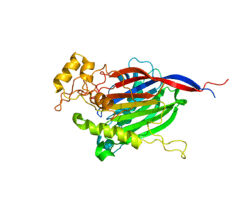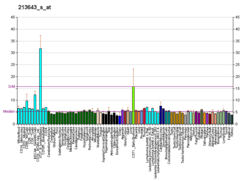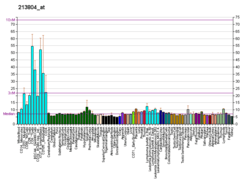INPP5B
Type II inositol-1,4,5-trisphosphate 5-phosphatase is an enzyme that in humans is encoded by the INPP5B gene.[5][6]
Cellular calcium signaling is controlled by the production of inositol phosphates (IPs) by phospholipase C in response to extracellular signals. The IP signaling molecules are inactivated by a family of inositol polyphosphate-5-phosphatases (5-phosphatases). This gene encodes the type II 5-phosphatase. The protein is localized to the cytosol and mitochondria, and associates with membranes through an isoprenyl modification near the C-terminus. Several alternatively spliced transcript variants of this gene have been described, but the full-length nature of some of these variants has not been determined.[6]
References
- 1 2 3 GRCh38: Ensembl release 89: ENSG00000204084 - Ensembl, May 2017
- 1 2 3 GRCm38: Ensembl release 89: ENSMUSG00000028894 - Ensembl, May 2017
- ↑ "Human PubMed Reference:".
- ↑ "Mouse PubMed Reference:".
- ↑ Ross TS, Jefferson AB, Mitchell CA, Majerus PW (Dec 1991). "Cloning and expression of human 75-kDa inositol polyphosphate-5-phosphatase". J Biol Chem. 266 (30): 20283–9. PMID 1718960.
- 1 2 "Entrez Gene: INPP5B inositol polyphosphate-5-phosphatase, 75kDa".
Further reading
- Mitchell CA, Connolly TM, Majerus PW (1989). "Identification and isolation of a 75-kDa inositol polyphosphate-5-phosphatase from human platelets". J. Biol. Chem. 264 (15): 8873–7. PMID 2542294.
- Jefferson AB, Majerus PW (1995). "Properties of type II inositol polyphosphate 5-phosphatase". J. Biol. Chem. 270 (16): 9370–7. doi:10.1074/jbc.270.16.9370. PMID 7721860.
- Jänne PA, Dutra AS, Dracopoli NC, et al. (1994). "Localization of the 75-kDa inositol polyphosphate-5-phosphatase (INPP5B) to human chromosome band 1p34". Cytogenet. Cell Genet. 66 (3): 164–6. doi:10.1159/000133691. PMID 8125013.
- Speed CJ, Matzaris M, Bird PI, Mitchell CA (1996). "Tissue distribution and intracellular localisation of the 75-kDa inositol polyphosphate 5-phosphatase". Eur. J. Biochem. 234 (1): 216–24. doi:10.1111/j.1432-1033.1995.216_c.x. PMID 8529643.
- Jänne PA, Rochelle JM, Martin-DeLeon PA, et al. (1996). "Mapping of the 75-kDa inositol polyphosphate-5-phosphatase (Inpp5b) to distal mouse chromosome 4 and its exclusion as a candidate gene for dysgenetic lens". Genomics. 28 (2): 280–5. doi:10.1006/geno.1995.1142. PMID 8530037.
- Strausberg RL, Feingold EA, Grouse LH, et al. (2003). "Generation and initial analysis of more than 15,000 full-length human and mouse cDNA sequences". Proc. Natl. Acad. Sci. U.S.A. 99 (26): 16899–903. doi:10.1073/pnas.242603899. PMC 139241. PMID 12477932.
- Ota T, Suzuki Y, Nishikawa T, et al. (2004). "Complete sequencing and characterization of 21,243 full-length human cDNAs". Nat. Genet. 36 (1): 40–5. doi:10.1038/ng1285. PMID 14702039.
- Gerhard DS, Wagner L, Feingold EA, et al. (2004). "The status, quality, and expansion of the NIH full-length cDNA project: the Mammalian Gene Collection (MGC)". Genome Res. 14 (10B): 2121–7. doi:10.1101/gr.2596504. PMC 528928. PMID 15489334.
- Barrios-Rodiles M, Brown KR, Ozdamar B, et al. (2005). "High-throughput mapping of a dynamic signaling network in mammalian cells". Science. 307 (5715): 1621–5. doi:10.1126/science.1105776. PMID 15761153.
- Kimura K, Wakamatsu A, Suzuki Y, et al. (2006). "Diversification of transcriptional modulation: large-scale identification and characterization of putative alternative promoters of human genes". Genome Res. 16 (1): 55–65. doi:10.1101/gr.4039406. PMC 1356129. PMID 16344560.
- Gregory SG, Barlow KF, McLay KE, et al. (2006). "The DNA sequence and biological annotation of human chromosome 1". Nature. 441 (7091): 315–21. doi:10.1038/nature04727. PMID 16710414.
This article is issued from
Wikipedia.
The text is licensed under Creative Commons - Attribution - Sharealike.
Additional terms may apply for the media files.






